HI6025 Accounting Theory: A Critical Review of AASB 16 Leases
VerifiedAdded on 2023/03/31
|6
|669
|103
Report
AI Summary
This report critically examines the Australian Accounting Standard Board's (AASB) new standard, AASB 16, concerning lease liabilities. Replacing the previous standard, AASB 16 mandates the inclusion of both lease assets and liabilities on a company's balance sheet, aiming to enhance financial statement transparency. The report discusses the benefits for investors, highlighting improvements in understanding a company's financial position through clearer financial leverage and capital employed metrics. It contrasts the accounting treatment of leases under IFRS 16 with borrowing to buy assets, noting that while economically similar, the accounting intentions differ. The analysis also addresses the issue of differentiating between operating and financial leases under IAS 17, a problem eliminated by IFRS 16's unified approach to lease accounting.
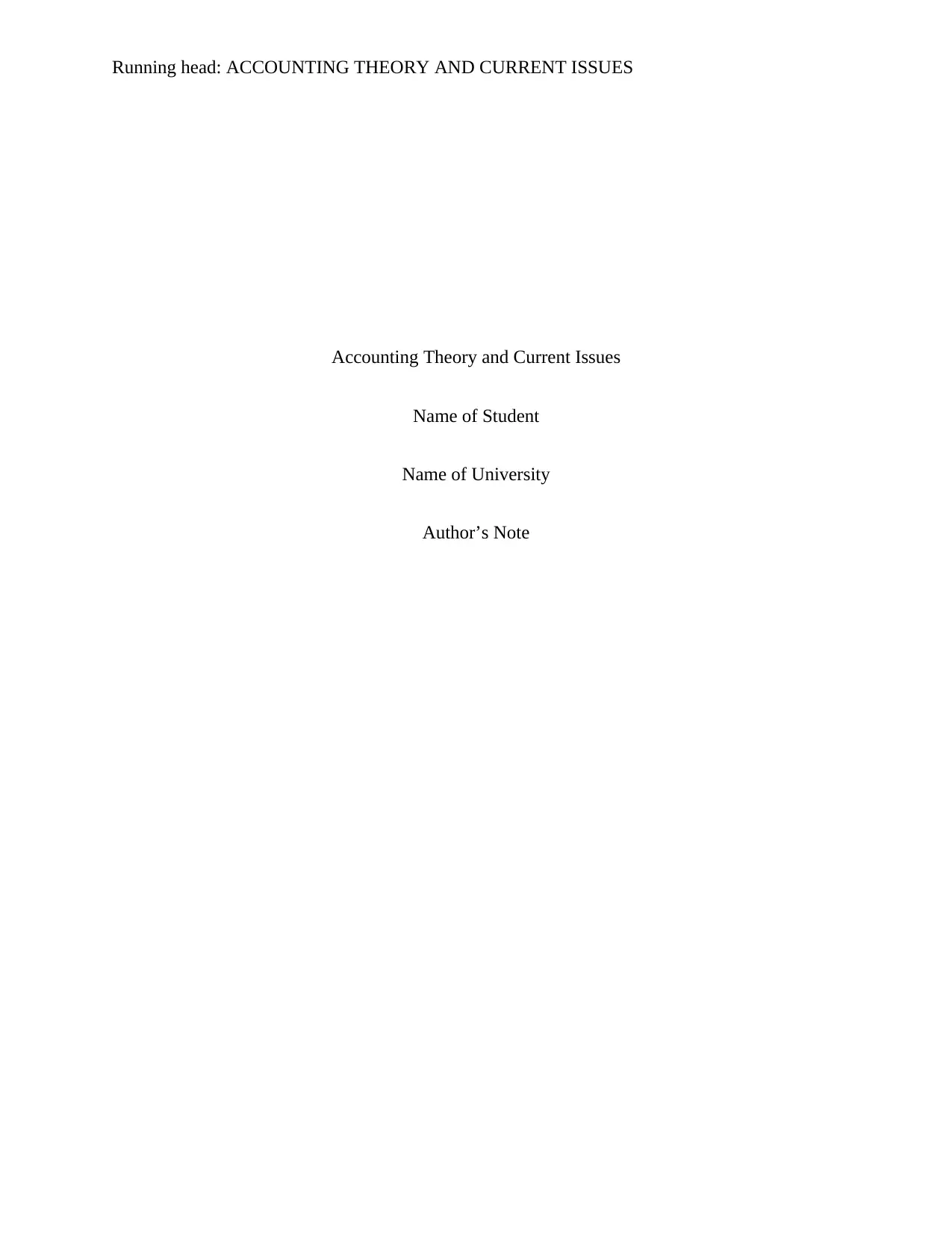
Running head: ACCOUNTING THEORY AND CURRENT ISSUES
Accounting Theory and Current Issues
Name of Student
Name of University
Author’s Note
Accounting Theory and Current Issues
Name of Student
Name of University
Author’s Note
Paraphrase This Document
Need a fresh take? Get an instant paraphrase of this document with our AI Paraphraser
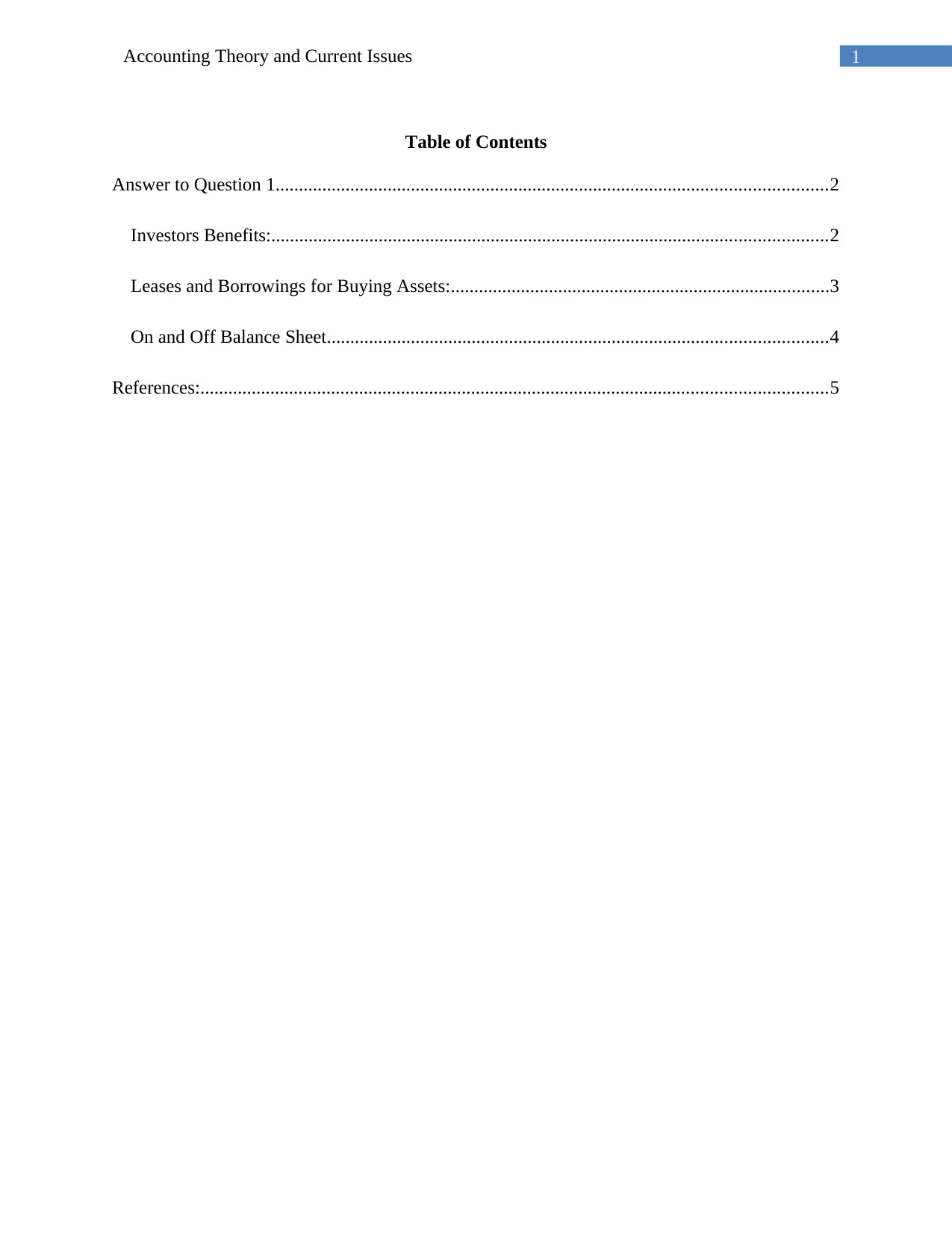
1Accounting Theory and Current Issues
Table of Contents
Answer to Question 1......................................................................................................................2
Investors Benefits:.......................................................................................................................2
Leases and Borrowings for Buying Assets:.................................................................................3
On and Off Balance Sheet...........................................................................................................4
References:......................................................................................................................................5
Table of Contents
Answer to Question 1......................................................................................................................2
Investors Benefits:.......................................................................................................................2
Leases and Borrowings for Buying Assets:.................................................................................3
On and Off Balance Sheet...........................................................................................................4
References:......................................................................................................................................5
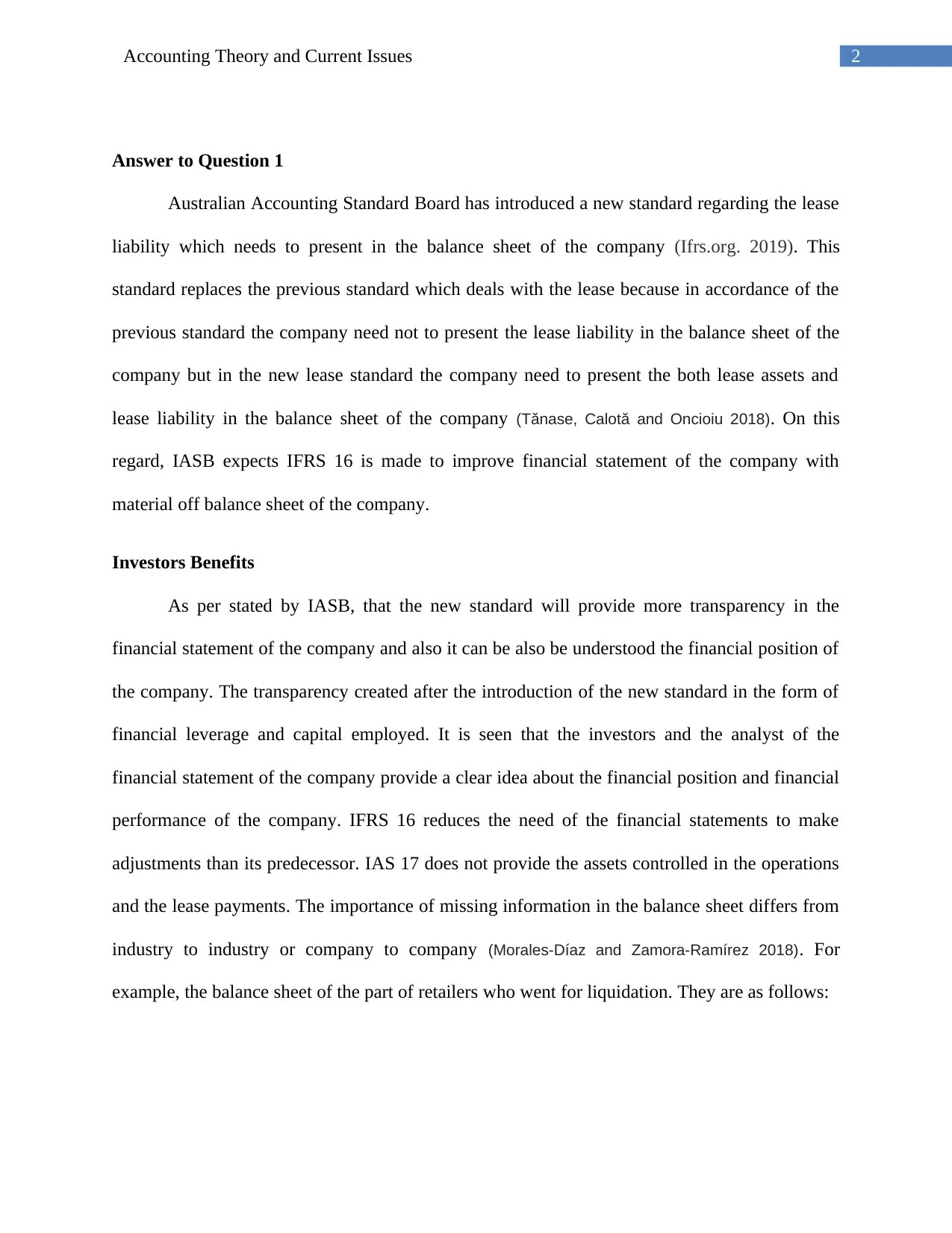
2Accounting Theory and Current Issues
Answer to Question 1
Australian Accounting Standard Board has introduced a new standard regarding the lease
liability which needs to present in the balance sheet of the company (Ifrs.org. 2019). This
standard replaces the previous standard which deals with the lease because in accordance of the
previous standard the company need not to present the lease liability in the balance sheet of the
company but in the new lease standard the company need to present the both lease assets and
lease liability in the balance sheet of the company (Tănase, Calotă and Oncioiu 2018). On this
regard, IASB expects IFRS 16 is made to improve financial statement of the company with
material off balance sheet of the company.
Investors Benefits
As per stated by IASB, that the new standard will provide more transparency in the
financial statement of the company and also it can be also be understood the financial position of
the company. The transparency created after the introduction of the new standard in the form of
financial leverage and capital employed. It is seen that the investors and the analyst of the
financial statement of the company provide a clear idea about the financial position and financial
performance of the company. IFRS 16 reduces the need of the financial statements to make
adjustments than its predecessor. IAS 17 does not provide the assets controlled in the operations
and the lease payments. The importance of missing information in the balance sheet differs from
industry to industry or company to company (Morales-Díaz and Zamora-Ramírez 2018). For
example, the balance sheet of the part of retailers who went for liquidation. They are as follows:
Answer to Question 1
Australian Accounting Standard Board has introduced a new standard regarding the lease
liability which needs to present in the balance sheet of the company (Ifrs.org. 2019). This
standard replaces the previous standard which deals with the lease because in accordance of the
previous standard the company need not to present the lease liability in the balance sheet of the
company but in the new lease standard the company need to present the both lease assets and
lease liability in the balance sheet of the company (Tănase, Calotă and Oncioiu 2018). On this
regard, IASB expects IFRS 16 is made to improve financial statement of the company with
material off balance sheet of the company.
Investors Benefits
As per stated by IASB, that the new standard will provide more transparency in the
financial statement of the company and also it can be also be understood the financial position of
the company. The transparency created after the introduction of the new standard in the form of
financial leverage and capital employed. It is seen that the investors and the analyst of the
financial statement of the company provide a clear idea about the financial position and financial
performance of the company. IFRS 16 reduces the need of the financial statements to make
adjustments than its predecessor. IAS 17 does not provide the assets controlled in the operations
and the lease payments. The importance of missing information in the balance sheet differs from
industry to industry or company to company (Morales-Díaz and Zamora-Ramírez 2018). For
example, the balance sheet of the part of retailers who went for liquidation. They are as follows:
⊘ This is a preview!⊘
Do you want full access?
Subscribe today to unlock all pages.

Trusted by 1+ million students worldwide
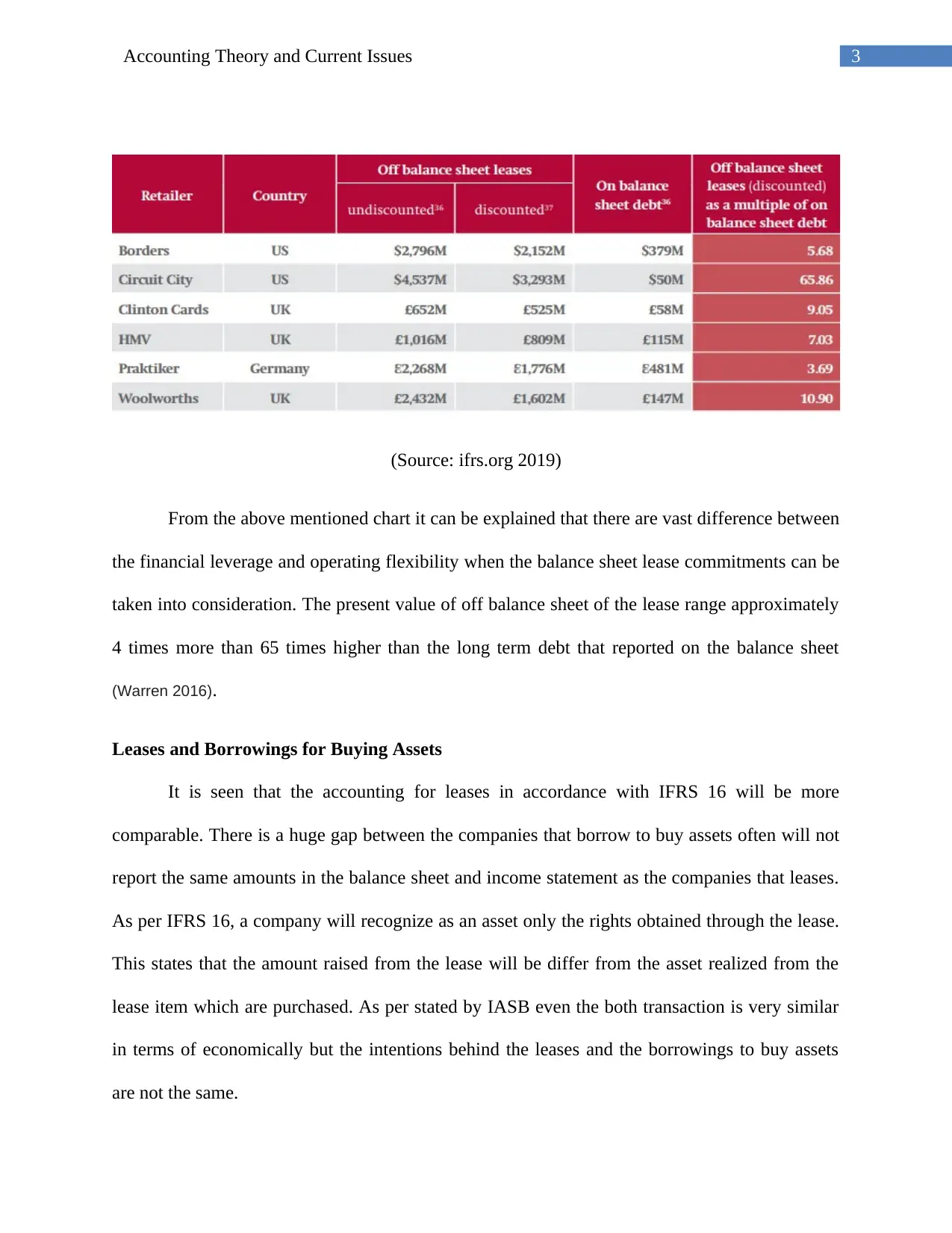
3Accounting Theory and Current Issues
(Source: ifrs.org 2019)
From the above mentioned chart it can be explained that there are vast difference between
the financial leverage and operating flexibility when the balance sheet lease commitments can be
taken into consideration. The present value of off balance sheet of the lease range approximately
4 times more than 65 times higher than the long term debt that reported on the balance sheet
(Warren 2016).
Leases and Borrowings for Buying Assets
It is seen that the accounting for leases in accordance with IFRS 16 will be more
comparable. There is a huge gap between the companies that borrow to buy assets often will not
report the same amounts in the balance sheet and income statement as the companies that leases.
As per IFRS 16, a company will recognize as an asset only the rights obtained through the lease.
This states that the amount raised from the lease will be differ from the asset realized from the
lease item which are purchased. As per stated by IASB even the both transaction is very similar
in terms of economically but the intentions behind the leases and the borrowings to buy assets
are not the same.
(Source: ifrs.org 2019)
From the above mentioned chart it can be explained that there are vast difference between
the financial leverage and operating flexibility when the balance sheet lease commitments can be
taken into consideration. The present value of off balance sheet of the lease range approximately
4 times more than 65 times higher than the long term debt that reported on the balance sheet
(Warren 2016).
Leases and Borrowings for Buying Assets
It is seen that the accounting for leases in accordance with IFRS 16 will be more
comparable. There is a huge gap between the companies that borrow to buy assets often will not
report the same amounts in the balance sheet and income statement as the companies that leases.
As per IFRS 16, a company will recognize as an asset only the rights obtained through the lease.
This states that the amount raised from the lease will be differ from the asset realized from the
lease item which are purchased. As per stated by IASB even the both transaction is very similar
in terms of economically but the intentions behind the leases and the borrowings to buy assets
are not the same.
Paraphrase This Document
Need a fresh take? Get an instant paraphrase of this document with our AI Paraphraser
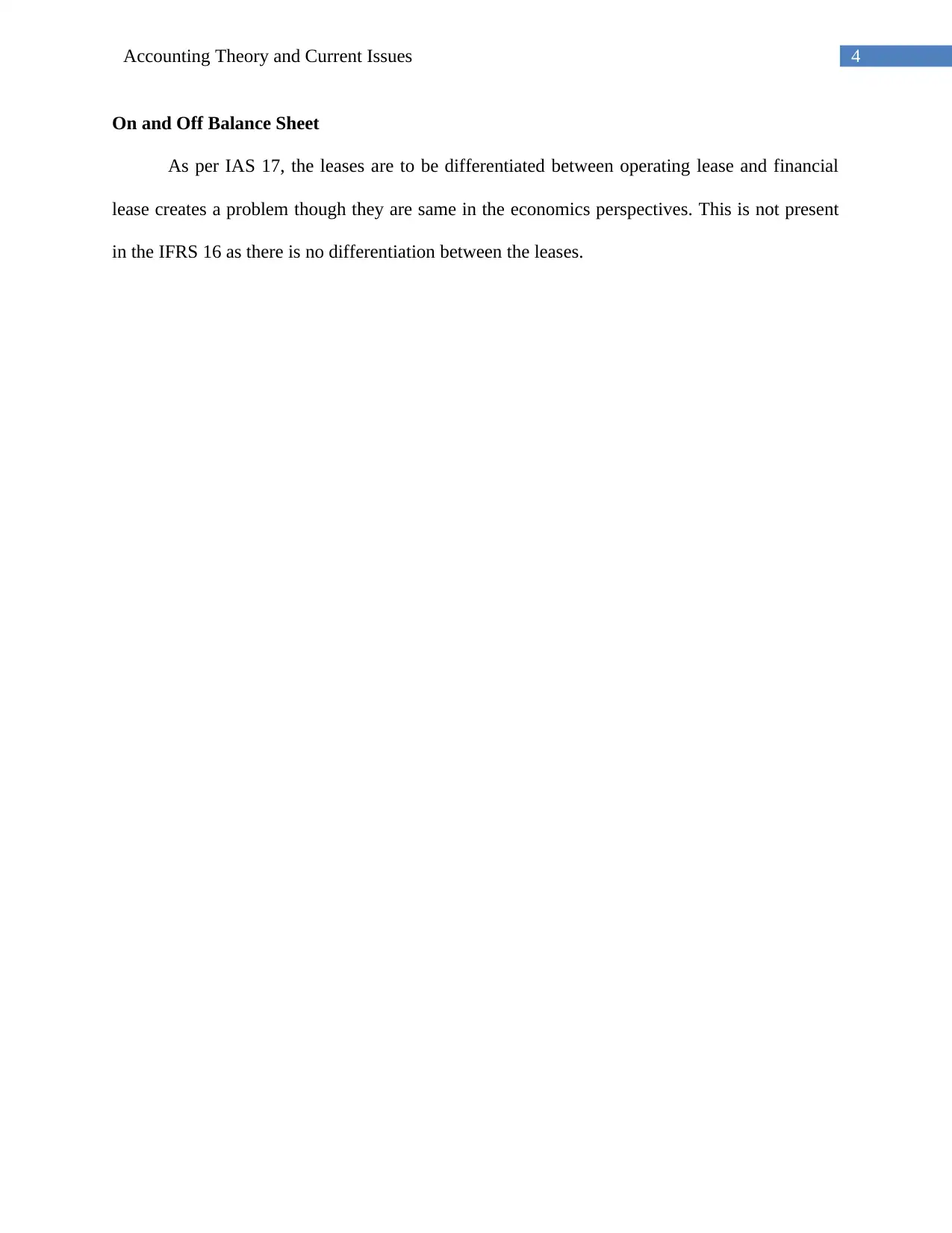
4Accounting Theory and Current Issues
On and Off Balance Sheet
As per IAS 17, the leases are to be differentiated between operating lease and financial
lease creates a problem though they are same in the economics perspectives. This is not present
in the IFRS 16 as there is no differentiation between the leases.
On and Off Balance Sheet
As per IAS 17, the leases are to be differentiated between operating lease and financial
lease creates a problem though they are same in the economics perspectives. This is not present
in the IFRS 16 as there is no differentiation between the leases.
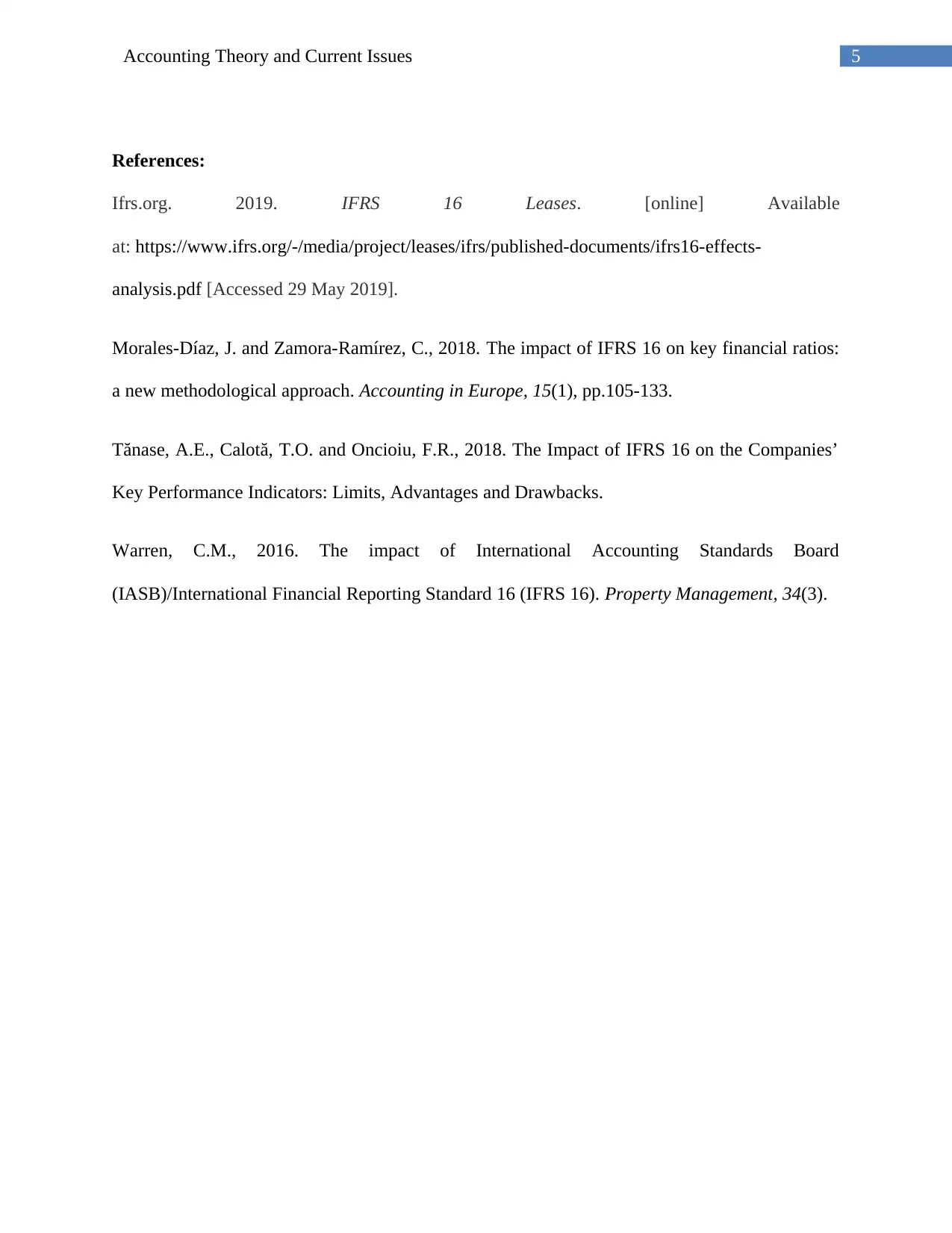
5Accounting Theory and Current Issues
References:
Ifrs.org. 2019. IFRS 16 Leases. [online] Available
at: https://www.ifrs.org/-/media/project/leases/ifrs/published-documents/ifrs16-effects-
analysis.pdf [Accessed 29 May 2019].
Morales-Díaz, J. and Zamora-Ramírez, C., 2018. The impact of IFRS 16 on key financial ratios:
a new methodological approach. Accounting in Europe, 15(1), pp.105-133.
Tănase, A.E., Calotă, T.O. and Oncioiu, F.R., 2018. The Impact of IFRS 16 on the Companies’
Key Performance Indicators: Limits, Advantages and Drawbacks.
Warren, C.M., 2016. The impact of International Accounting Standards Board
(IASB)/International Financial Reporting Standard 16 (IFRS 16). Property Management, 34(3).
References:
Ifrs.org. 2019. IFRS 16 Leases. [online] Available
at: https://www.ifrs.org/-/media/project/leases/ifrs/published-documents/ifrs16-effects-
analysis.pdf [Accessed 29 May 2019].
Morales-Díaz, J. and Zamora-Ramírez, C., 2018. The impact of IFRS 16 on key financial ratios:
a new methodological approach. Accounting in Europe, 15(1), pp.105-133.
Tănase, A.E., Calotă, T.O. and Oncioiu, F.R., 2018. The Impact of IFRS 16 on the Companies’
Key Performance Indicators: Limits, Advantages and Drawbacks.
Warren, C.M., 2016. The impact of International Accounting Standards Board
(IASB)/International Financial Reporting Standard 16 (IFRS 16). Property Management, 34(3).
⊘ This is a preview!⊘
Do you want full access?
Subscribe today to unlock all pages.

Trusted by 1+ million students worldwide
1 out of 6
Related Documents
Your All-in-One AI-Powered Toolkit for Academic Success.
+13062052269
info@desklib.com
Available 24*7 on WhatsApp / Email
![[object Object]](/_next/static/media/star-bottom.7253800d.svg)
Unlock your academic potential
Copyright © 2020–2025 A2Z Services. All Rights Reserved. Developed and managed by ZUCOL.





